This part of the 6th Edition of the InsideIIM Alumni Reports will cover the FMCG Industry. Here, the top Consumer Goods brands have been selected on the basis of the InsideIIM Recruitment Survey Report, followed by an analysis of the alumni base of 16 revered management institutes of the country currently working in these companies. We will look at absolute numbers of alumni in each company and compare percentages of alumni in 2 ways –
- Which school has the highest representation of a company among its ‘peers’?
- Which company has the highest percentage of alumni for a given business school?
(Peers are defined based on the year of establishment of the business school. More details below)
Why do we create this report every year?
1) To help potential aspirants know about a business school’s reputation in the corporate world.
2) It helps current students and alumni get an overall picture of their own alumni and facilitates more targeted networking.
Creation of 2 Business School Clusters – Pre 1966 and Post 1966
Top b-schools in India are divided into two categories based on the years in which they were established. The rationale behind such a selection criterion is to ensure that the alumni base is strong and comparable for the B-schools under consideration. As there was no top b-school established between 1965 and 1973, the cut-off year chosen for dividing the schools is taken to be 1965. This criterion divides the schools into two clusters – Cluster 1 – Pre-1966 and Cluster 2 – Post-1966 – having 8 schools in each cluster.
The table summarises these clusters with the year of establishment:
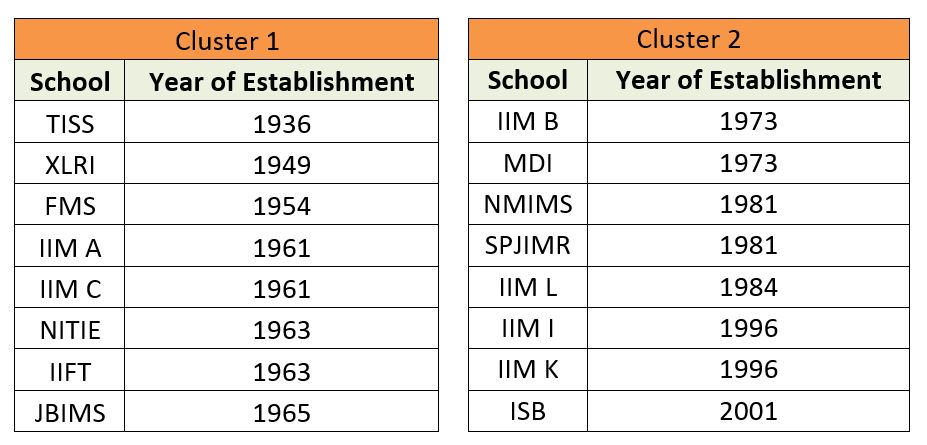
Analysis of Alumni in Consumer Goods Companies:
A total of 17 companies were considered for obtaining a holistic picture of alumni of b-schools working in any of the domains. The list of companies is considered to be a comprehensive representation of the popular recruiters across the various top b-schools.
The Pre 1966 Top Business Schools
Given below is the raw data from LinkedIn for the 8 Schools in this cluster of schools established prior to 1966. Please note that –
1) No filtration has been done for job profile. Hence, the figures below represent every role and domain – the numbers below include Alumni in Sales & Marketing, Operations, IT, Corporate Finance, HR and other domains.
2) All possible business of a Sales and Marketing company have been considered. For e.g. – HUL below consists of employees from Hindustan Unilever, Unilever etc.
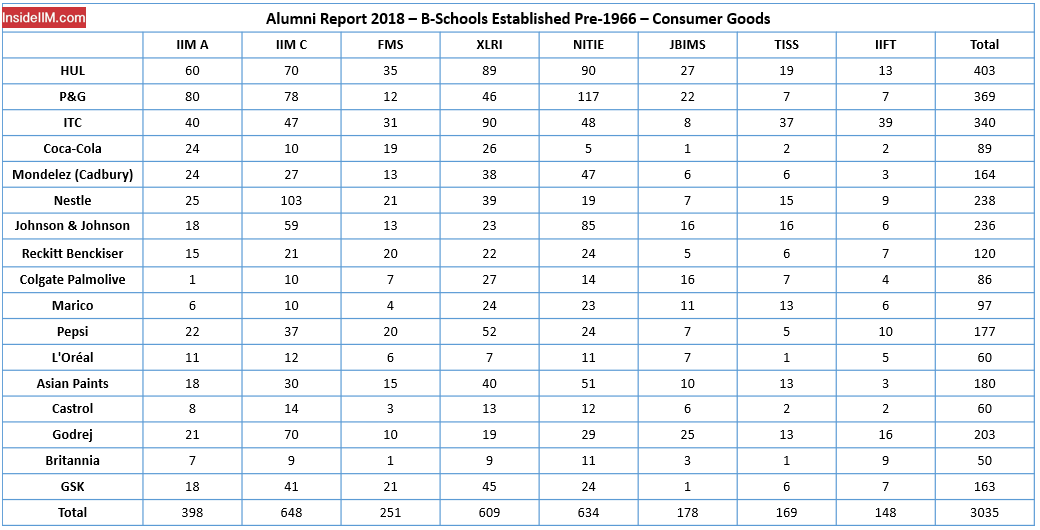
Alumni strength as a percentage of the total number of alumni working at these top brands:
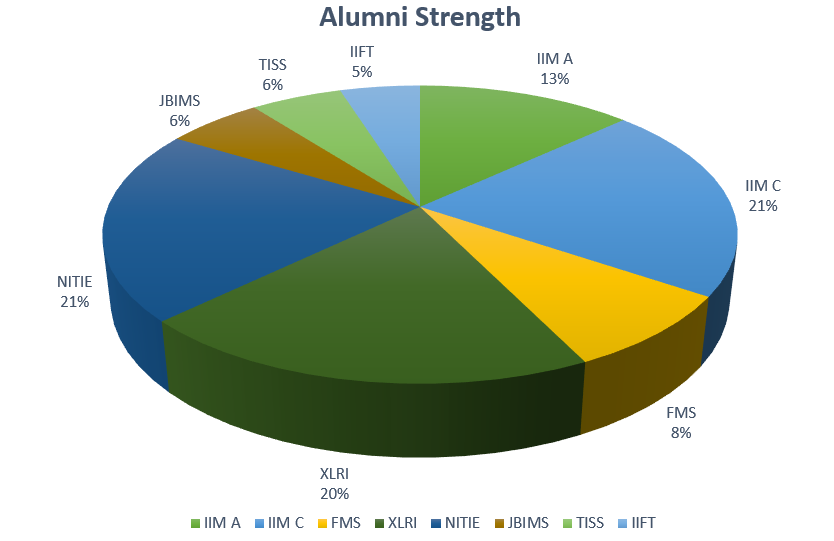
The analysis done below gives a detailed look into:
– Company wise slicing of Alumni across Category 1 b-schools.
– Cumulative percentage of alumni working in different companies.
% of Alumni in each Company from each of the 8 Top Schools established prior to 1966
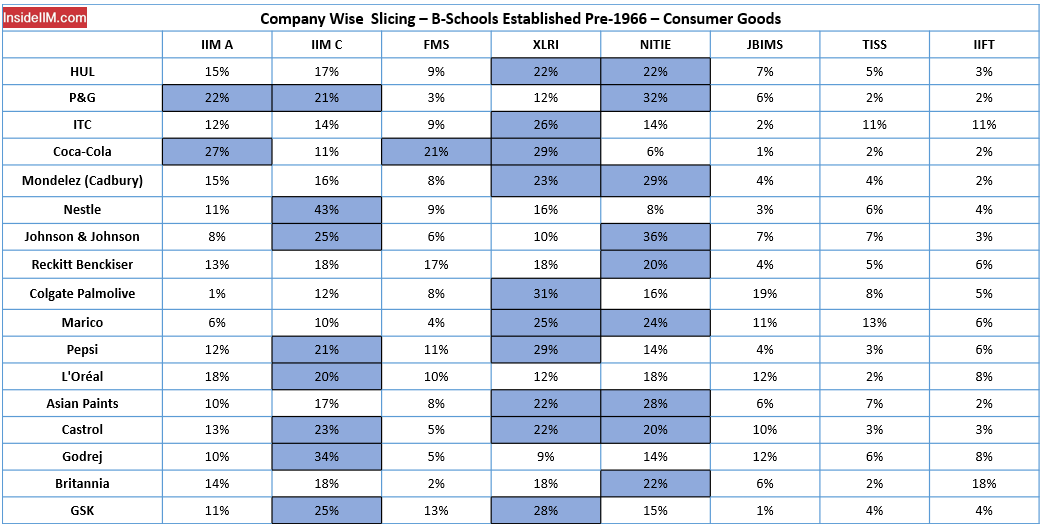
Reference: Percentage of Alumni crossing 20% has been marked blue.
Key Takeaways
From the figures above, we can conclude that:
- We see that XLRI, along with NITIE, is one of the most dominant management institutes in the FMCG industry. On LinkedIn, most of the profiles at these brands were of Human Resource Managers/Talent Acquisition Managers. This goes on to show that HR Managers from XLRI dominate the FMCG industry. Similarly, Operations oriented profiles from NITIE go on to prove that specializations help.
- Alumni numbers from HUL, P&G and ITC have stood out yet again and comprise 37% of the total number of alumni in the FMCG industry. These brands have always had the most number of alumni since the inception of the InsideIIM Alumni Reports. On the other end of the spectrum, Castrol, L'Oreal and Britannia have historically had the smallest alumni base amongst all 17 companies.
- The maximum number of alumni at Nestle are from IIM Calcutta (almost half). This is also true for the previous years' Alumni Reports and shows IIM C graduates' clear inclination to the largest FMCG brand in the world.
- JBIMS and TISS are under-represented compared to other business schools. Even FMS, being the third oldest business school in this cluster, is relatively less represented for Consumer Goods. This is surprising, considering FMS is known for its Sales & Marketing roles and sees significant representation only in Coca-Cola and RB.
- IIFT continues to be wanting in terms of representation in these top-brands, considering it was established in the same year as the well-represented NITIE (Although the batch strength of the latter is 1.5 times larger than that of the former). Delhi based schools have always appeared to be under-represented in our Alumni Reports.
- Finally, an obvious conclusion (atleast for this cluster) is the importance of batch strength to determine representation. Recruiters are looking for a large pool of students to recruit from. Institutes such as IIFT, JBIMS, TISS and FMS have half the batch strength and see a significantly lesser representation as compared to their counterparts who have a batch-intake of over 350 students every year.
% of Total Alumni from each of the 8 Top Schools established prior to 1966 – in each company
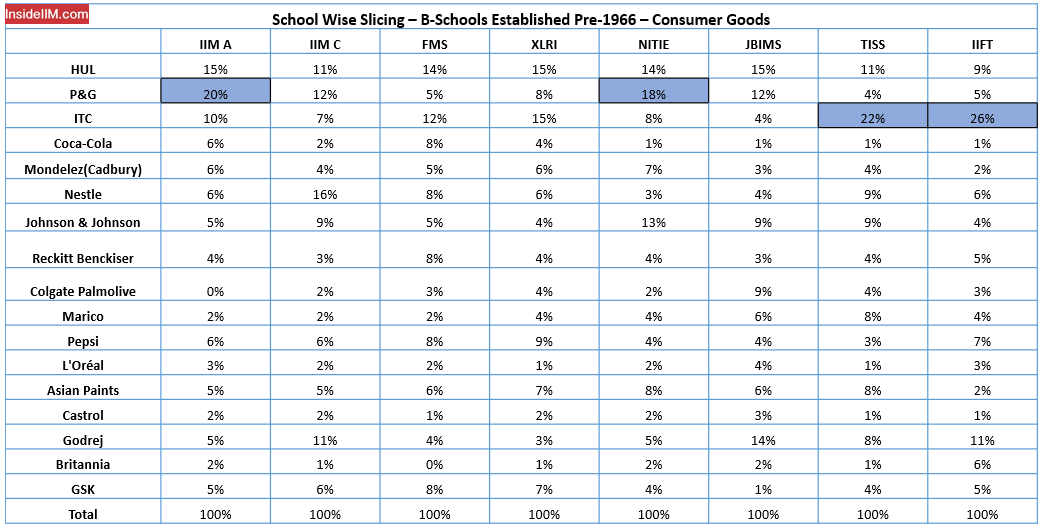
Reference: Percentage of Alumni crossing 18% has been marked blue.
Key Takeaways:
From the figures above, 3 main conclusions that can be drawn are:
- IIM Ahmedabad has always been well represented at Procter & Gamble, and along with JBIMS, has just missed out on the 18% mark for Unilever.
- The preponderance of TISS and IIFT alumni at ITC has continued to exist ever since the inception of this series.
- XLRI, NITIE and IIM Calcutta appear to be the most represented management institutes and enjoy a good distribution across companies. These institutes constitute over 60% of the total alumni base in this cluster.
The Post 1966 Top Business Schools
Given below is the raw data from LinkedIn for the 8 Schools in this cluster of schools established prior to 1966. Please note that:
1) No filtration has been done for job profile. Hence, the figures below represent every role and domain – the numbers below include Alumni in Sales & Marketing, Operations, IT, Corporate Finance, HR and other domains.
2) All possible business of a sales and marketing company have been considered. For e.g. – HUL below consists of employees from Hindustan Unilever, Unilever etc. Cadbury includes employees from both Cadbury and Mondelez International.
3) NMIMS also has many undergraduate degrees. The figures for SBM - NMIMS could be influenced heavily because of this as B.Com, BBA, B.Sc. Eco graduates are also counted along with the post-graduation MBA. Also, we have seen many examples of Narsee Monjee College of Commerce and Economics graduates label themselves under NMIMS by mistake on LinkedIn.

Alumni strength as a percentage of the total number of alumni working at these top brands:

% of Alumni in each Company from each of the 8 Top Schools established after 1966
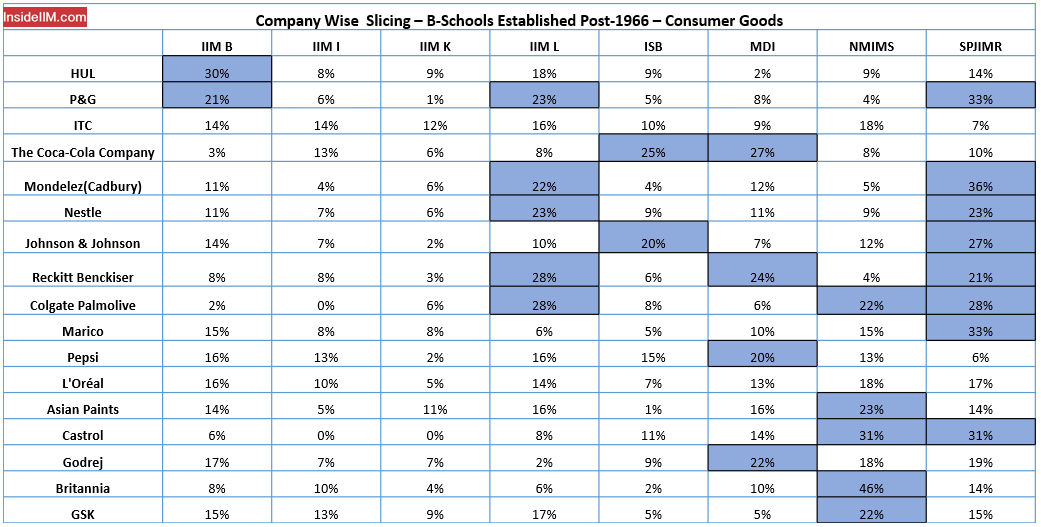
Reference: Percentage of Alumni crossing 20% has been marked blue.
Key Takeaways:
- The main highlight of this cluster is that the SPJIMR alumni constitute a formidable 33% of the total number of alumni working there. Despite having the smallest batch strength across all b-schools in this cluster, SPJIMR is also the most well-represented across companies in this cluster of b-schools.
- HUL and P&G appear to be the most popular companies amongst the alumni of IIM Bangalore and IIM Lucknow, who constitute 47% (HUL) and 44% (P&G) of the total number of alumni working there.
- IIM Indore and IIM Kozikhode are under-represented as compared to other b-schools in this cluster.
% of Total Alumni from each of the 8 Top Schools established after 1966 – in each company
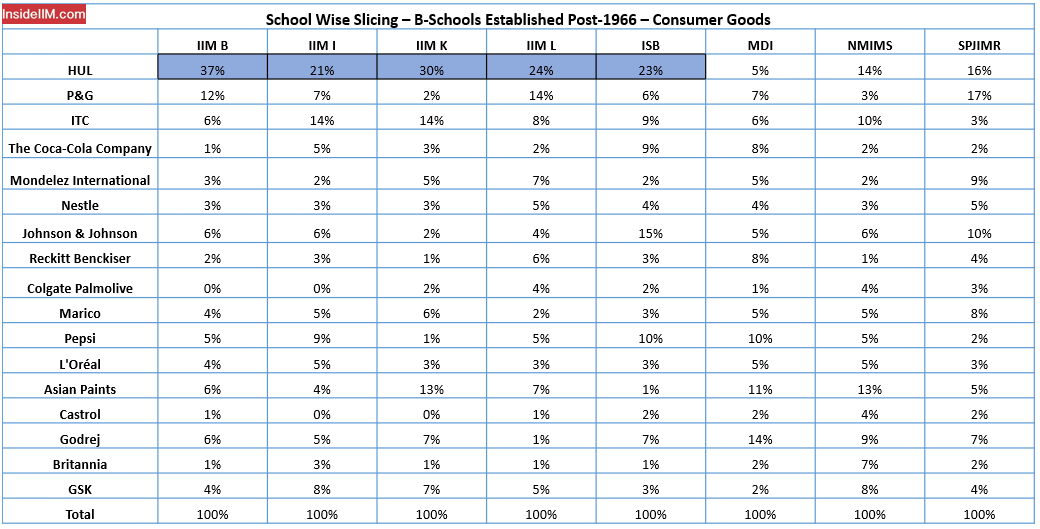
Reference: Percentage of Alumni crossing 18% has been marked blue.
Key Takeaways:
- As seen in previous years, HUL forms a huge part of the alumni base in this sector for almost all of the 8 b-schools except MDI. SPJIMR just misses out on the 18% mark for both HUL and P&G.
- Based on the alumni strength in this cluster, IIM Bangalore, IIM Lucknow, and SPJIMR have the highest percentage of alumni across these brands.
- IIM Indore and IIM Kozhikode have the least number of alumni across these companies despite their batch size.
Limitations of the report:
- The first evident limitation is the fact that not everyone is on LinkedIn. And even if they are on LinkedIn, they may not necessarily update their employment data.
- Often, some LinkedIn users fail to update their profiles, as a result of which the profile shows that they work for 2-3 companies simultaneously, which is highly unlikely.
- The report includes summer interns, as well as those who may hold certifications from these institutes or were a part of SDP (Short Duration Programs) at these institutes.
- Prima facie, it may seem that a larger number of alumni determines the strength of the b-school. However, the quality of roles offered plays an extremely important part in understanding placements and the quality of the alum base of the respective b-school. For e.g. There is a substantial difference between working in a front-end investment banking role and working in a KPO. These points are not illustrated in these reports owing to the subjectivity involved.
